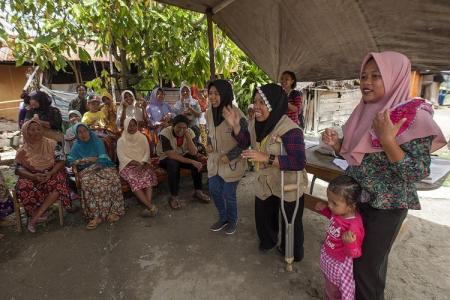
(c)Dwi Oblo/ASB Indonesia and the Philippines. Two members of a Disabled People's Organisation (DPO), wearing khaki vests, are delivering a hygiene promotion session for community members of Mantikole Village, Sigi, Central Sulawesi, Indonesia
By Yuki Matsuoka
Kobe, 25 June 2019 – The Sendai Framework Voluntary Commitment (SFVC) first Synthesis and Analysis Report was launched in Geneva during the recent Global Platform. Voluntary Commitments (VCs) are made by multiple stakeholders (private sector, local governments, civil society organizations, academia, media, etc.) in support of the implementation of the Sendai Framework, the global roadmap for reducing disaster loses by 2030.
During the launch, three selected stakeholders had the opportunity to share their experiences; Lily Kusumowardoyo, Disability –Inclusive Disaster Risk Reduction Network (DiDRRN); Alessandro Attolico, Province of Potenza; and Veronica Ruiz, International Union for Conservation of Nature (IUCN).
Ms. Kusumowardoyo highlighted that the public learn “not only about our commitment to support Sendai Framework but also how we plan to deliver our promises and when … it helps us to be more accountable in translating our commitment into real actions.”
“We can learn about what others are doing to support the implementation of Sendai Framework, which in turn, facilitate collaborations across wider stakeholders,” said Ms. Kusumowardoyo.
In addition, the presenters recognized the responsiveness and human touch of the team behind the platform while encouraging others to make their commitments.
The report presents a synthesis and analysis of why voluntary commitments are important, the characteristics of the commitment and their contribution to implementing the Sendai Framework. The main results suggest that VCs have an average duration of 6.5 years, the scope of their activities is predominantly at the national or local levels (58 percent) and are concentrated mainly in the Asia region (55 percent).